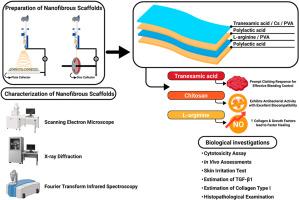智能敷料与氨甲环酸注入对齐电纺纳米纤维加速伤口愈合:体外和体内评估
IF 4.9
3区 医学
Q1 PHARMACOLOGY & PHARMACY
Journal of Drug Delivery Science and Technology
Pub Date : 2025-09-17
DOI:10.1016/j.jddst.2025.107542
引用次数: 0
摘要
先进的伤口敷料能够加速愈合和实现有效止血的发展仍然是创伤和外科伤口管理的关键挑战。本研究报道了一种由氨甲环酸(TXA)、壳聚糖(CS)、聚乙烯醇(PVA)、l -精氨酸和聚乳酸(PLA)组成的新型多层三明治结构纳米纤维支架的制备和综合评价。采用连续静电纺丝技术,开发了一种四层支架作为智能伤口敷料,包括用于快速凝血的立即释放的TXA-CS-PVA层,用于保护的疏水性PLA屏障层,用于促进组织再生的缓释l -精氨酸- pva层,以及用于增强耐久性的最终PLA保护层。采用平板集热器和旋转圆盘集热器对纳米纤维的形貌和排列进行优化,分别获得了随机和排列的纳米纤维结构。表征研究证实了支架成功的氨甲环酸(TXA)包封和结构完整性。体外细胞毒性试验显示出良好的生物相容性,而体内全层伤口模型显示出更好的伤口愈合率,胶原沉积增强,TGF-β1表达升高,皮肤刺激最小。值得注意的是,与随机纤维和市场上销售的配方相比,具有排列纤维和更薄PLA屏障的支架显著加速了愈合。这些发现突出了多层电纺纳米纤维支架作为一种有效的可生物降解伤口敷料的潜力,它不仅能加速止血,还能促进伤口愈合。本文章由计算机程序翻译,如有差异,请以英文原文为准。

Smart dressings accelerating wound healing with tranexamic acid-infused aligned electrospun nanofibers: In vitro and In vivo assessments
The development of advanced wound dressings capable of accelerating healing and achieving effective hemostasis remains a critical challenge in managing traumatic and surgical wounds. This study reports the fabrication and comprehensive evaluation of a novel multilayered, sandwich-structured nanofiber scaffold composed of Tranexamic acid (TXA), chitosan (CS), polyvinyl alcohol (PVA), L-arginine, and polylactic acid (PLA) for biodegradable wound dressing applications. Using sequential electrospinning, a four-layered scaffold was developed as a smart wound dressing, comprising an immediate-release TXA-CS-PVA layer for rapid clotting, a hydrophobic PLA barrier layer for protection, a sustained-release L-arginine-PVA layer to promote tissue regeneration, and a final PLA protective layer to enhance durability. The morphology and fiber alignment were optimized by employing both flat plate and rotating disc collectors to achieve random and aligned nanofiber structures, respectively. Characterization studies confirmed successful Tranexamic acid (TXA) encapsulation and structural integrity of the scaffolds. In vitro cytotoxicity tests showed excellent biocompatibility, while in vivo full-thickness wound models demonstrated superior wound closure rates, enhanced collagen deposition, and elevated TGF-β1 expression with minimal skin irritation. Notably, scaffolds with aligned fibers and thinner PLA barriers significantly accelerated healing compared to random fibers and marketed formulations. These findings highlight the promising potential of the fabricated multilayered electrospun nanofiber scaffold as an effective biodegradable wound dressing that not only accelerates hemostasis but also promotes enhanced wound healing.
求助全文
通过发布文献求助,成功后即可免费获取论文全文。
去求助
来源期刊
CiteScore
8.00
自引率
8.00%
发文量
879
审稿时长
94 days
期刊介绍:
The Journal of Drug Delivery Science and Technology is an international journal devoted to drug delivery and pharmaceutical technology. The journal covers all innovative aspects of all pharmaceutical dosage forms and the most advanced research on controlled release, bioavailability and drug absorption, nanomedicines, gene delivery, tissue engineering, etc. Hot topics, related to manufacturing processes and quality control, are also welcomed.

 求助内容:
求助内容: 应助结果提醒方式:
应助结果提醒方式:


